|
|
 |
|
Cyclopoida ( Order ) |
|
|
|
Oithonidae ( Family ) |
|
|
|
Oithona ( Genus ) |
|
|
| |
Oithona decipiens Farran, 1913 (F) | |
| | | | | | | Syn.: | | | | | Ref.: | | | Farran, 1913 a (p.184, Descr.F, figs.F); Rosendorn, 1917 a (p.26, Rem.F); Kiefer, 1929 g (p.7, Rem.F); Mori, 1937 (1964) (p.111, figs.F); Sewell, 1948 (p.430); Lindberg, 1955 a (p.464: Rem.); Chiba & al., 1957 (p.310); 1957 a (p.12); Wellershaus, 1970 (p.483: Rem.F); Kos, 1972 (Vol.I,figs.F, Rem.); Chen & al., 1974 (p.32, figs.F, p.74: Rem., Tab.1); Nishida & al., 1977 (p.133, figs.F, Rem.); Shuvalov, 1980 (p.119, figs.F); Ferrari & Bowman, 1980 (p.10, figs.F); Nishida, 1985 a (p.38, Redescr., figs.F, p.128); 1986 (p.386); Yoo & Lim, 1993 (p.91, 94, 98, Table 1); Kim & al., 1993 (p.271); Chihara & Murano, 1997 (p.937, Pl.194: F); Avancini & al., 2006 (p.121, Pl. 89, figs.F, Rem.); Vives & Shmeleva, 2010 (p.56, figs.F, Rem.) |  issued from : F.D. Ferrari & T.E. Bowman in Smiths. Contr. Zool., 1980, 312. [p.10, Fig.5]. Female (from Caribbean area): a, urosome (lateral left side); b, P4. Nota: Knob near genital opening armed with a single, thick, curved spine, toothed on posterior edge. Endopodal segment 2 of P4 both setae modified, slightly curved, distal thicker than proximal, with more well-developed flange on distal 1/4. endopodal esgment 3 of P4 proximal setae thickened with flange on distal 193. Nishida & al (1977) report some specimens with 0-0-1 outer setae on exopodal segments of P4 (Ferrari and Bowman agree with Kiefer (1936) that variation in spine number is important in separating species, a more extensive survey of the Sagami Bay should be made in order to resolve this reported variation).
|
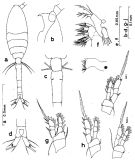 Issued from : S. Nishida in Bull. Ocean Res. Inst., Univ. Tokyo, 1985, No 20. [p.39, Fig.17]. Female: a, habitus (dorsal); b, forehead (lateral); c, last thoracic segment 5 and genital segment (dorsal); d, anal segment and caudal rami (dorsal); e, Md (biting edge); f, Mx1; g, P1; h, P2; i, P3; j, P4. Nota: Mx1: inner lobe 1 with 3 thick distal marginal setae about equal in length; outer lobe 2 with 1 seta, ; inner lobe 2 without seta, inner lobe 3 with 1 thick spinulose seta, 1 longer seta and 1 fine short seta; basipodal segment 2 rudimentary, without seta; endopodite small oval without seta; exopodite with 3 setae. Proportional lengths of urosome segments and caudal ramus 13:34:15: 13:13:12. Nota after C.R.: Setal formula on outer margin (in first) and inner margin (in second) of exopod segments (from proximal to distal) of P1 to P4: P1: 1, *, 2; 0, 1, 4. P2: 1, 1, 2; 0, 1, 5 P3: 1, *, 1; 0, 1, 5. P4: 0, 0, *; 0, 1, 5. * = very tiny spine.
|
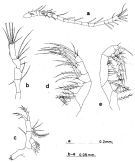 Issued from : S. Nishida in Bull. Ocean Res. Inst., Univ. Tokyo, 1985, No 20. [p.40, Fig.18]. Female: a, A1; b, A2; c, Md; d, Mx2; e, Mxp. Nota: Basipodal segment 2 of Md with 2 strong, slightly curved, spinulose subequal spines on distal end, and 1 seta about middle of inner margin; endopodite small with 3 or 4 setae.
|
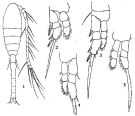 issued from : Q.-c Chen & S.-z. Zhang & C.-s. Zhu in Studia Marina Sinica, 1974, 9. [Pl.1, Figs.1-5]. Female (from China Seas): 1, habitus (dorsal); 2, P1; 3, P2; 4, P3; 5, P4. Nota: Farran (1913) described that the exopod 2 of female P1 is without an inner seta and the exopod 3 of female P4 is without an outer spine, but the specmens here agree well with the Rosendorn's (1917) description.
|
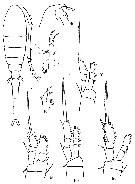 issued from : G.P. Farran in Proc. zool. Soc. Lond., 1913. [Plate XXVIII, Figs.4-11]. Female (from Christmas Island, Indian): 4, forehead (lateral); 5, Md (mandibular palp); 6, Mx1; 7, habitus (dorsal); 8-11, P1 to P4.
|
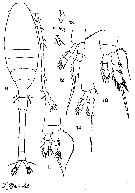 issued from : T. Mori in The Pelagic copepoda from the neighbouring waters of Japan, 1937 (1964). [Pl. 61, Figs.9-14]. Female: 9, habitus (dorsal); 10, P2; 11, P1; 12, P3; 13, Md; 14, P4.
|
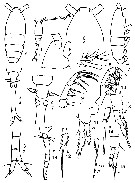 issued from : V.S. Shuvalov in Opred. Faune SSSR, Nauka, Leningrad, 1980, 125. [p.120, Fig.26]. Female: 1, prosome (dorsal); 2, 18, thoracic segments 4 and 5, abdomen (dorsal and lateral, respectively); 3, posterior part of urosome (dorsal); 4, habitus (dorsal); 5-6, forehead (lateral and dorsal, respectively); 7, prosome (lateral); 8, A2; 9, Mx2; 10, Mxp; 11, P2; 12, P2 (segments 2 and 3 of exopod); 13, P3; 14, P3 (distal segment of exopod); 15, P4; 16, P4 (distal segment of exopod); 17, thoracic segment 5 and genital segment.
|
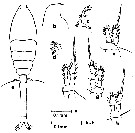 Issued from : S. Nishida, O. Tanaka & M. Omori in Bull. Plankton Soc. Japan, 1977, 24 (2). [p.134, Fig.7]. Female (from Suruga Bay and adjacent waters): a, habitus (dorsal), b, forehead (lateral); c, Md; d, Mx1; e, P1; f, P2; g, P3; h, P4. Nota: Setae formula of exopod P1 to P4 (outer setae in first, inner setae in second). P1: 1,02; 0,1,4. P2: 1,1,2; 0,1,5. P3: 1,0,1; 0,1,5. P4: 0,0,0 (or 1); 0,1,5. Exopodite 3 of P3 with 1 tooth on the outer margin. Prosome length/urosome length = 1.16-1.28.
|
 Issued from K.-I. & D.-H. Lim in The Korean J. Syst. Zool., 1993, 9 (2). [Key of female]: ]Morphological characters of Oithona decipiens female in Korean waters :
1 - Anterior part of prosome rounded in dorsal view.
2 - Rostrum pointed ventrally. 3 - Length of A1 longer than that of prosome. 4 - Exopod 2nd segment of P1 without spine.
| | | | | Compl. Ref.: | | | Yamazi, 1958 (p.153, Rem.); V.N. Greze, 1963 a (tabl.2); Shmeleva, 1964 a (p.1068); Pavlova, 1966 (p.44); Delalo, 1968 (p.138); Kovalev & Shmeleva, 1982 (p.85); Guangshan & Honglin, 1984 (p.118, tab.); Greze & al., 1985 (p.8); Yoo, 1991 (tab.1); Shih & Young, 1995 (p.74); Hure & Krsinic, 1998 (p.103); Suarez-Morales & Gasca, 1998 a (p.111); Ueda & al., 2000 (tab.1); Hsieh & al., 2004 (p.398, tab.1); Mazzocchi & al., 2005 (p.155); Prusova & Smith, 2005 (p.76); Shmeleva & al., 2008 (p.31, Table 1); Hernandez-Trujillo & al., 2010 (p.913, Table 2); Mazzocchi & Di Capua, 2010 (p.428); Selifonova, 2011 a (p.77, Table 1, alien species in Black Sea); Mazzocchi & al., 2011 (p.1163, fig.6, long-term time-series 1984-2006); Mazzocchi & al., 2012 (p.135, annual abundance 1984-2006); Uysal & Shmeleva, 2012 (p.909, Table I); Johan & al., 2012 (2013) (p.1, Table 1); Gubanova & al., 2013 (in press, p.4, Table 2); in CalCOFI regional list (MDO, Nov. 2013; M. Ohman, comm. pers.); Tachibana & al., 2013 (p.545, Table 1, seasonal change 2006-2008); Mazzocchi & al., 2014 (p.64, Table 4, 5, abundance); Benedetti & al., 2016 (p.159, Table I, fig.1, functional characters); Benedetti & al., 2018 (p.1, Fig.2: ecological functional group); Palomares-Garcia & al., 2018 (p.178, Table 1: occurrence) | | | | NZ: | 11 | | |
|
Distribution map of Oithona decipiens by geographical zones
|
| | | | | | | | | | | |  Issued from : S. Nishida in Bull. Ocean Res. Inst., Univ. Tokyo, 1985, No 20. [p.128, Fig.76]. Issued from : S. Nishida in Bull. Ocean Res. Inst., Univ. Tokyo, 1985, No 20. [p.128, Fig.76].
Indo-Pacific geographical distribution of Oithona decipiens. Dotted line: AC, Arctic Convergence; SC, Subtropical Convergence. |
| | | | Loc: | | | Venezuela, Ibero-moroccan Bay, Medit. (Alboran Sea, Ligurian Sea, G. of Napoli, Adriatic Sea, Ionian Sea, Aegean Sea, Lebanon Basin, W Black Sea: Black River estuary), Red Sea, Arabian Sea, Indian, Malaysia (Sarawak: Bintulu coast), Philippines, China Seas (Yellow Sea, East China Sea, South China Sea), W & S Taiwan, S & E Korea, Japan, Tanabe Bay, Tokyo Bay, Pacif. (W equatorial), Pacif. (equatorial, tropical), W Baja California (Bahia Magdalena, La Paz), SE Pacif. | | | | N: | 48 | | | | Lg.: | | | (91) F: ± 0,75; (109) F: 0,67-0,55; (155) F: 0,67-0,64; (624) F: 0,72-0,6; (627) F: 0,81-0,61; (634) F: 0,62-0,56; (649) F: 0,59; (880) F: 0,56-0,75; (1230) F: 0,56-0,75; (1239) F: 0,68-0,75; {F: 0,55-0,81} | | | | Rem.: | epi-mesopelagic.
Characters female after Rosendorn (1917 a, p.26): Proportion of lengths (p.cent) Prosome : 55.17, Urosome : 44.83 . Relative lengths of urosomal segments and caudal rami: 6: 17: 7: 6.5: 7: 6 : 9 : 30 : 15 : 14 : 12 : 12. Setal formula of the exopod swimming legs P1 to P4 (Se = outer setae ; Si = inner setae), P1 : 1, 0, 2 Se ; 0, 1, 4 Si ; P2 : 1, 1, 2 Se ; 0, 1, 5 Si ; P3 : 1, 0, 1 Se ; 0, 1, 5 Si ; P4 : 0, 0, 1 Se ; 0, 1, 5 Si .
After Benedetti & al. (2018, p.1, Fig.2) this species belonging to the functional group 6 corresponding to small ambush feeding omnivorous.
Ater Yoo & Lim (1993, p.96) the discrimination between this species and Oithona similis on the basis of external morphology is very difficulty. But the number of marginal spine in P21-P4 exipod of O. decipiens is different from that of O. similis. For O. decipiens the formula is 1-0-2; 1-1-2; 1-0-1; 0-0-0, wherea O. similis has 1-1-2; 1-0-1; 1-0-1; 0-0-1. | | | Last update : 19/06/2023 | |
|
|
 Any use of this site for a publication will be mentioned with the following reference : Any use of this site for a publication will be mentioned with the following reference :
Razouls C., Desreumaux N., Kouwenberg J. and de Bovée F., 2005-2025. - Biodiversity of Marine Planktonic Copepods (morphology, geographical distribution and biological data). Sorbonne University, CNRS. Available at http://copepodes.obs-banyuls.fr/en [Accessed December 04, 2025] © copyright 2005-2025 Sorbonne University, CNRS
|
|
 |
 |












